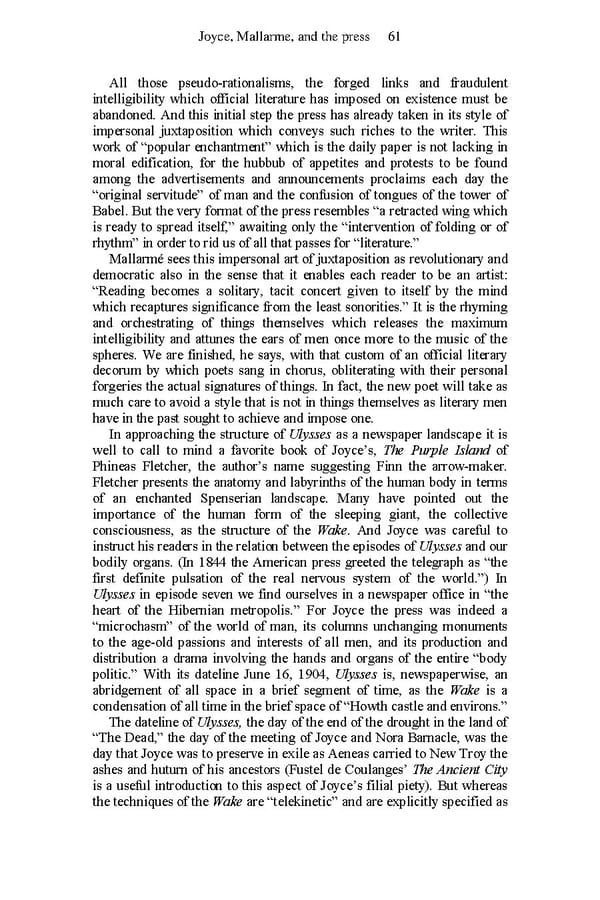Joyce, Mallarme, and the press 61 All those pseudo-rationalisms, the forged links and fraudulent intelligibility which official literature has imposed on existence must be abandoned. And this initial step the press has already taken in its style of impersonal juxtaposition which conveys such riches to the writer. This work of “popular enchantment” which is the daily paper is not lacking in moral edification, for the hubbub of appetites and protests to be found among the advertisements and announcements proclaims each day the “original servitude” of man and the confusion of tongues of the tower of Babel. But the very format of the press resembles “a retracted wing which is ready to spread itself,” awaiting only the “intervention of folding or of rhythm” in order to rid us of all that passes for “literature.” Mallarmé sees this impersonal art of juxtaposition as revolutionary and democratic also in the sense that it enables each reader to be an artist: “Reading becomes a solitary, tacit concert given to itself by the mind which recaptures significance from the least sonorities.” It is the rhyming and orchestrating of things themselves which releases the maximum intelligibility and attunes the ears of men once more to the music of the spheres. We are finished, he says, with that custom of an official literary decorum by which poets sang in chorus, obliterating with their personal forgeries the actual signatures of things. In fact, the new poet will take as much care to avoid a style that is not in things themselves as literary men have in the past sought to achieve and impose one. In approaching the structure of Ulysses as a newspaper landscape it is well to call to mind a favorite book of Joyce’s, The Purple Island of Phineas Fletcher, the author’s name suggesting Finn the arrow-maker. Fletcher presents the anatomy and labyrinths of the human body in terms of an enchanted Spenserian landscape. Many have pointed out the importance of the human form of the sleeping giant, the collective consciousness, as the structure of the Wake. And Joyce was careful to instruct his readers in the relation between the episodes of Ulysses and our bodily organs. (In 1844 the American press greeted the telegraph as “the first definite pulsation of the real nervous system of the world.”) In Ulysses in episode seven we find ourselves in a newspaper office in “the heart of the Hibernian metropolis.” For Joyce the press was indeed a “microchasm” of the world of man, its columns unchanging monuments to the age-old passions and interests of all men, and its production and distribution a drama involving the hands and organs of the entire “body politic.” With its dateline June 16, 1904, Ulysses is, newspaperwise, an abridgement of all space in a brief segment of time, as the Wake is a condensation of all time in the brief space of “Howth castle and environs.” The dateline of Ulysses, the day of the end of the drought in the land of “The Dead,” the day of the meeting of Joyce and Nora Barnacle, was the day that Joyce was to preserve in exile as Aeneas carried to New Troy the ashes and huturn of his ancestors (Fustel de Coulanges’ The Ancient City is a useful introduction to this aspect of Joyce’s filial piety). But whereas the techniques of the Wake are “telekinetic” and are explicitly specified as
 Essential McLuhan Page 67 Page 69
Essential McLuhan Page 67 Page 69